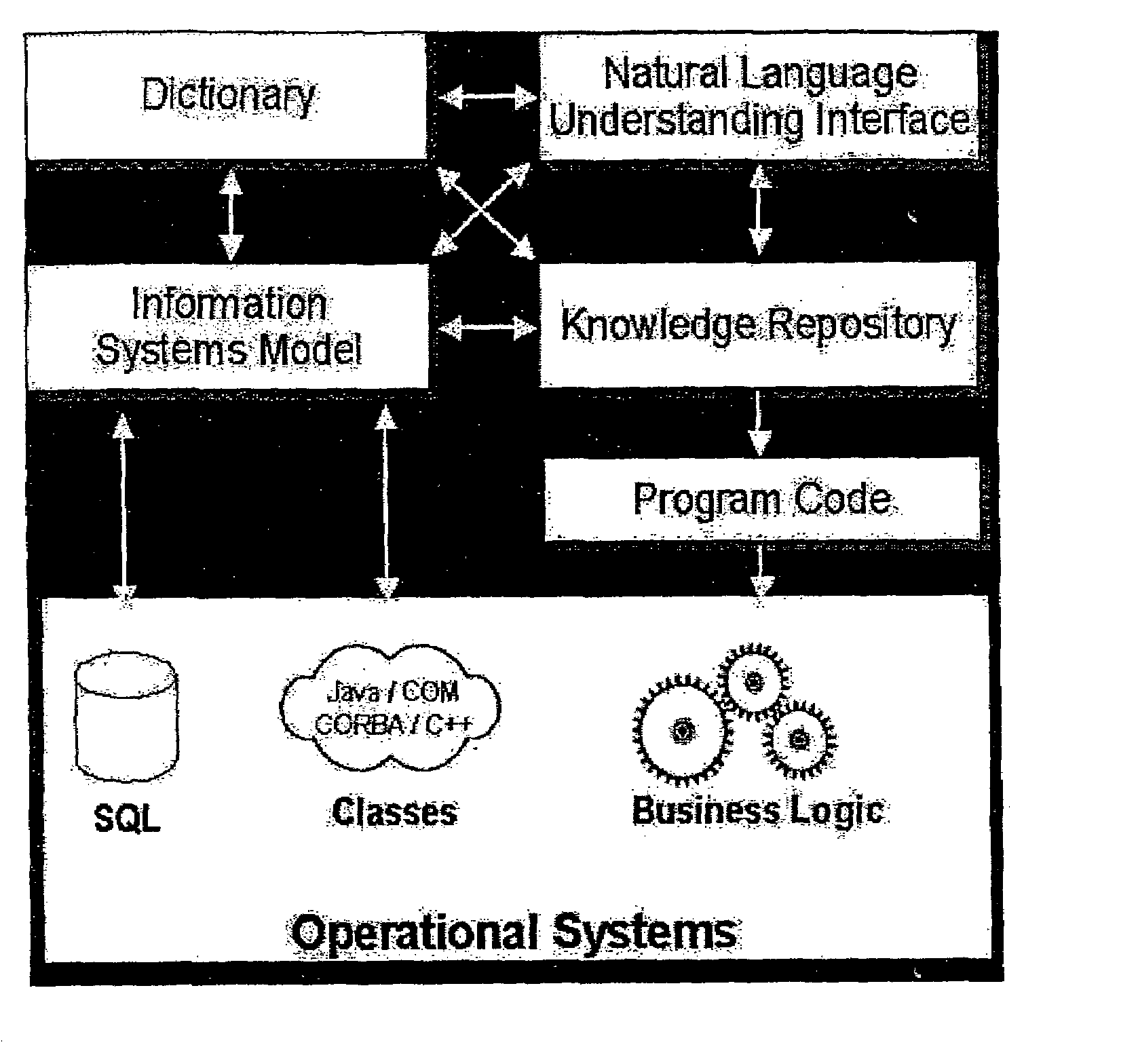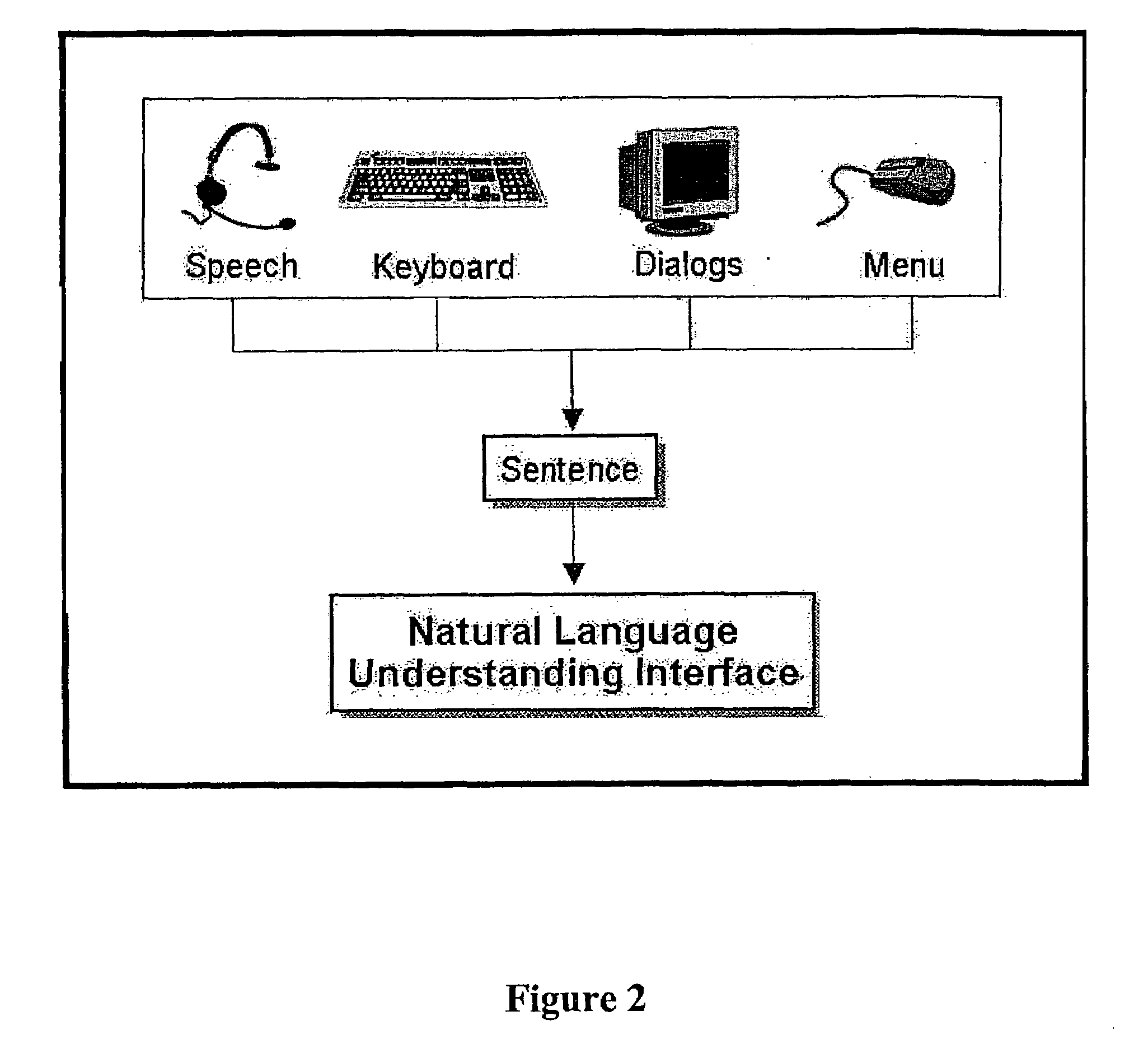The prior art does not disclose the translation of knowledge expressed in
natural language into operational logic within programs.
Moreover, the systems of the prior art are strictly syntactic with very little ability to understand the
semantics of natural language.
These products have the distinct
disadvantage that they do not address the issue of managing knowledge about an underlying object or
data model.
The systems of the prior art have the distinct
disadvantage that they do not have the ability to represent knowledge about a model (e.g., sentences constructed from such vocabularies) or to define knowledge prior to the implementation of a model.
The systems of the prior art have the additional
disadvantage that they aim only to provide end users with access to data rather than to manage the definition of a model throughout its life cycle within and across an enterprise.
Consequently, if the vocabularies and mappings of these systems are shared, untrained users may incorrectly define or alter mappings from the vocabulary into the model.
Any such change, whether or not correct and appropriate, becomes permanent and destructive, without substantial support for version control, user privileges or object permissions.
The systems of the prior art have the additional disadvantage that they parse input from users according to syntactic rules and limited vocabularies.
Because users cannot reasonably be fully aware of the restrictions imposed on their grammar by such rules, they are often frustrated when their input is rejected as non-grammatical.
In addition, because the syntactic rules and word senses of the vocabulary are typically ambiguous, users are often frustrated when their grammatical input is misinterpreted.
Conventional knowledge management systems have the significant disadvantage that they make no effort to formally acquire, analyze, and understand the lexical, syntactic, and grammatical structure of sentences within the text they manage.
Consequently, these knowledge management systems are incapable of reliably translating such sentences between natural languages or into
computer software expressed in any
programming language.
These products have the distinct disadvantage that they do not parse, acquire, or validate a document at the level of sentences.
Consequently, the prior art is incapable of ensuring that each
sentence within the
knowledge base is semantically consistent and unambiguous.
Moreover, without a semantically consistent and unambiguous understanding of every
sentence in a
knowledge base,
automatic translation between natural languages (e.g., English or Spanish to or from French or German) is unreliable.
Established
software design methodologies have the distinct disadvantage that they distinguish between the requirements and specifications of the business and the
software implementation of such requirements and specifications.
Knowledge management systems of the prior art have no capability to generate software, as discussed above.
Such design tools are limited to generating models into which programmers manually implement code reflecting separately documented
business policies.
This manual intervention and implementation results in inordinate delays and poor reliability.
Consequently, established
software design methodologies suffer from the disadvantages that they emphasize comprehensive yet detailed design before and long cycle times between each version of the resulting software.
To the extent that the work product of programmers is distinct from the work product of analysts,
business process automation in the systems of the prior art has the disadvantage of communications overhead and its attendant costs and risks of
confusion or
ambiguity.
This disadvantage also applies to the extent that the work product of the analysts is distinct from the statements or perspective of the operational, managerial, or executive
business personnel from whom analysts gather business rules.
As described above concerning software design methodology, the statements of traditional (i.e., procedural, including object-oriented) programming languages have the distinct disadvantage that they are not isomorphic to the requirements or specifications stated by operational, managerial, or executive
business personnel.
As discussed above, this disadvantage in design also manifests itself during the development process in that changes in the requirements or specifications cannot be incrementally reflected in
source code.
In either case, the prior art continues to suffer from the distinct disadvantage that
business personnel cannot directly specify statements with the formality required by rule-based programming languages and their engines or code generators.
The disadvantage of the prior art concerning triggers is that the resulting implementation is less efficient and scalable than using a
rule engine.
Moreover, the Rete
Algorithm has no intrinsic support for organizing the application of rules within a
decision making process nor for coping with logical inconsistencies between statements authored by one or more users of a knowledge
management system.
Consequently, the prior art is incapable of supporting the resolution of inconsistencies or inadequacies in the collective sentences of a knowledge
management system or of auditing the applicability of individual sentences in a knowledge management system.
Thus, the prior art does not facilitate the testing, monitoring, or improvement of the knowledge managed.
However, the
granularity of version control in the prior art is too coarse for a knowledge management system that manages a vocabulary and sentences expressed using that vocabulary.
Consequently, the prior art is unable to manage knowledge that is accumulated incrementally by acquiring and maintaining dictionary definitions of words and sentences that use previously acquired vocabulary with subsequently modifiable dictionary definitions.
The prior art has no effective ability to manage versions of statements at such a level of
granularity, particularly where certain words in the vocabulary used within such statements may be restricted to certain authors or groups of authors and where words in the vocabulary are related to implementation details maintained as software model information within the knowledge management system where such software model information is itself subject to version control.
However, all the forgoing is beyond the current state of the art in knowledge management and source code control systems.
Isolated
word recognition is awkward other than for very limited purposes and is becoming less relevant as the quality of continuous
speech recognition systems increases.
Probabilistic word sequence models do not ensure syntactically correct recognition, however, and neither approach can ensure that what is recognized is semantically clear and unambiguous.
Consequently, the prior art is incapable of the
natural language processing required in order to capture grammatically correct and unambiguous knowledge.
 Login to View More
Login to View More  Login to View More
Login to View More 


